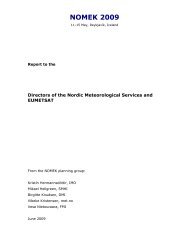International Symposium on Mitigative Measures against Snow ...
International Symposium on Mitigative Measures against Snow ...
International Symposium on Mitigative Measures against Snow ...
You also want an ePaper? Increase the reach of your titles
YUMPU automatically turns print PDFs into web optimized ePapers that Google loves.
<str<strong>on</strong>g>Internati<strong>on</strong>al</str<strong>on</strong>g> <str<strong>on</strong>g>Symposium</str<strong>on</strong>g> <strong>on</strong> <strong>Mitigative</strong> <strong>Measures</strong> <strong>against</strong> <strong>Snow</strong> Avalanches<br />
Egilsstaðir, Iceland, March 11–14, 2008<br />
In the next decades the towns grew steadily with the excepti<strong>on</strong> of the depressi<strong>on</strong> years in the<br />
1930s. No avalanche disasters with many fatalities occurred in urban areas.<br />
During 1965−1980, the populati<strong>on</strong> increased in many fishing towns in Iceland. Many houses<br />
were built and avalanche risk was not a top priority in the plans. During that period, many<br />
settlements expanded towards the mountainsides. Since the towns were reaching into areas<br />
where no houses or buildings had been before, avalanche records were often scarce. However,<br />
many houses were built in areas were avalanches were still in the memories of people. In<br />
some towns, like Patreksfjörður and Siglufjörður vacant areas existed where building of<br />
houses was not allowed due to avalanche hazard. However, there was often a pressure to<br />
allow buildings in such areas from individuals or local governments. The off- limit areas<br />
gradually became smaller and it seems like in some cases that the outline of the most resent<br />
large avalanche defined the boundary.<br />
When two avalanches killed 12 people in Neskaupstaður in 1974, it took the inhabitants of the<br />
town and the rest of the Icelandic people by a surprise. It seems like nobody had imagined this<br />
could happen. Nevertheless, in 1936, avalanches had threatened houses in both of these<br />
avalanche paths.<br />
HAZARD MAPS<br />
The first avalanche hazard maps were made shortly after the avalanche accidents in<br />
Neskaupstaður by local governments No acti<strong>on</strong>s followed the hazard maps in terms of<br />
relocating or protecting the settlement, however, the first organised snow observati<strong>on</strong>s started<br />
at that time.<br />
The first laws <strong>on</strong> avalanche protecti<strong>on</strong> were approved in 1985 after avalanche accidents in<br />
Ólafsvík and after that, the first legislati<strong>on</strong> based hazard maps was made. At that time, the<br />
growth of the fishing towns had stopped and very few houses were built during the rest of the<br />
century.<br />
In 1995, two avalanche disasters in Súðavík and Flateyri, with a total of 34 fatalities, marked<br />
a change in the attitude towards avalanche risk in Iceland. Most of the victims were in houses<br />
that were outside of the hazard z<strong>on</strong>es according to the hazard maps at that time. During the<br />
next years, the methodology of hazard mapping was reviewed in Iceland, and new laws and<br />
legislati<strong>on</strong> were approved. Since then, hazard maps have been made for most of the towns<br />
with the greatest avalanche risk. Where houses in urban areas are in hazard z<strong>on</strong>e C (the<br />
greatest risk), the local governments are obliged to make a plan for either protecting or<br />
relocating the settlement. There are examples of both in Iceland, however, the trend now is to<br />
build defence structures rather than to relocate houses.<br />
In 1995−2005, the populati<strong>on</strong> in most of the towns outside of the Reykjavík area was<br />
shrinking. Very few houses were built and, therefore, the new hazard maps did not have a<br />
great effect <strong>on</strong> the spatial development of the towns. In the last few years, however,<br />
c<strong>on</strong>structi<strong>on</strong> of houses has started again, and the spatial development is directed outside of the<br />
hazard z<strong>on</strong>es.<br />
Grímsdóttir 159











